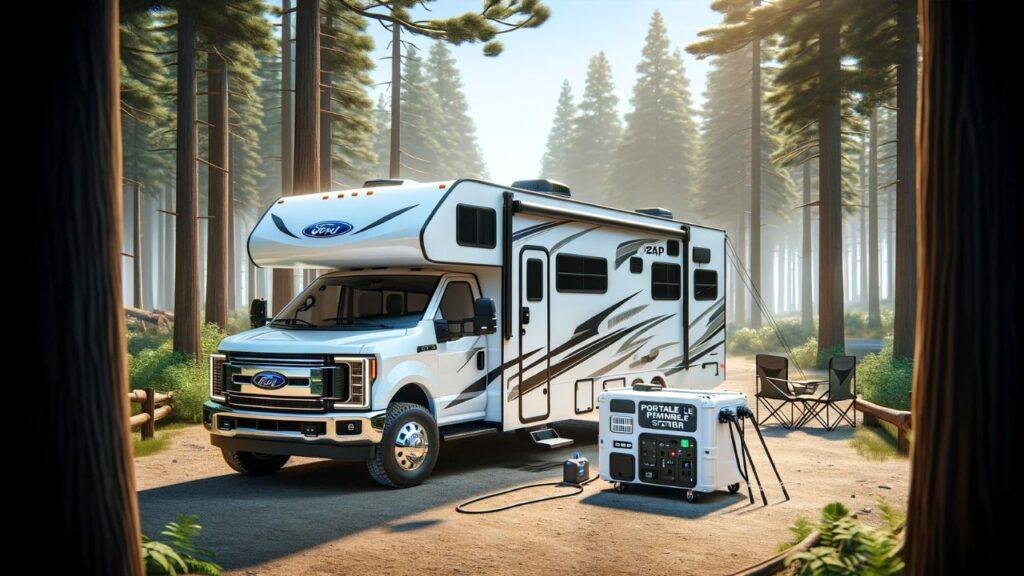
Owning an RV comes with its fair share of adventures and challenges, and leveling your rig is one of those tasks that can make or break a camping experience. As someone who has spent countless nights under the stars in my own RV, I know the importance of getting this right. So the question comes, is it okay to level an rv with jack stands?
The average RV weighs a hefty 10,000 to 12,000 pounds, and using jack stands improperly can lead to dangerous equipment failure.
If you’re part of the 11.2 million U.S. households that own an RV, or one of the million Americans embracing the full-time RV lifestyle, knowing how to safely level your RV is a must.
Is It Okay to Level an RV with Jack Stands?
You can use jack stands to level an RV, but it’s not the safest or most recommended method. While jack stands are handy for temporary fixes or maintenance, they’re not designed for the long-term weight distribution required in leveling a 10,000–12,000-pound vehicle.
Jack stands work by supporting specific points of your RV’s frame, but this can cause frame flexing or twisting, especially if the weight isn’t evenly distributed. Additionally, jack stands are less stable on uneven ground, making them risky to use in many camping situations.
As an RV enthusiast, I’ve seen people attempt this method, only to struggle with shifting rigs or even damage to the chassis. If you decide to use jack stands, it’s critical to follow strict safety protocols—more on that below.
Ultimately, safer and more efficient options, like leveling blocks or hydraulic systems, are better suited for most RV owners. These alternatives are designed specifically for the job, providing stability and peace of mind.
Why Proper Leveling is Essential for Your RV
Leveling your RV is not just about comfort—it protects your investment and keeps everything running smoothly. Here are some quick reasons why it matters:
- Appliance Performance: RV refrigerators and water heaters are designed to operate on level surfaces; a tilt can cause them to malfunction or break.
- Structural Stability: An unlevel RV puts unnecessary stress on the frame, which could lead to costly repairs down the road.
- Plumbing Efficiency: Uneven leveling affects drainage systems, leading to clogs or leaks.
- Sleeping Comfort: Nobody wants to slide off their mattress in the middle of the night!
- Safety: A stable RV is less likely to shift or wobble, especially in windy conditions or during movement inside.
Pros and Cons of Using Jack Stands for Leveling
Jack stands might seem like a budget-friendly solution, but they come with their fair share of trade-offs.
Pros
If you’re in a pinch, jack stands can get the job done temporarily:
- Affordable: Jack stands are cheaper than hydraulic or automated systems.
- Compact: They’re easy to store and transport.
- Versatile: You can use them for other maintenance tasks, like changing tires.
Cons
The drawbacks, however, make jack stands less than ideal for leveling:
- Limited Stability: They’re prone to slipping or shifting, especially on uneven surfaces.
- Risk of Frame Damage: Improper placement can cause stress or twisting in your RV’s frame.
- Not Designed for Long-Term Use: Jack stands are built for short-term support, not extended camping stays.
- Setup Challenges: Achieving a perfectly level RV with jack stands can be time-consuming and tricky.
Safe Practices if You Decide to Use Jack Stands
If you’re set on using jack stands to level your RV, you need to be extra cautious. This method leaves little room for error, so safety should always come first. Here are a few must-follow tips:
- Choose Heavy-Duty Stands – Use stands rated for your RV’s weight, preferably with extra capacity for added safety.
- Level the Ground First – Park on solid, even terrain. Avoid soft surfaces like grass or gravel.
- Use at Least Four Stands – Place them evenly at load-bearing points near the axles to prevent frame flexing.
- Add Wheel Chocks – Secure all tires that remain on the ground to prevent rolling.
- Slow and Steady – Raise the RV gradually and double-check each stand’s position as you go.
- Test Stability – Before calling it done, give the RV a gentle push to check for movement.
Safer Alternatives for Leveling Your RV
Jack stands might work in a pinch, but if you’re serious about RV living, it’s worth looking into safer and easier leveling options. Here are a few tried-and-true methods:
Manual Leveling Blocks
Leveling blocks are like Legos for adults—stack them under your tires until your RV sits just right. They’re affordable, lightweight, and work well for minor adjustments.
I always keep a set in my rig because you never know when you’ll need them. Just drive onto the blocks, check your level, and make quick tweaks as needed.
Electric or Hydraulic Leveling Systems
If you want to make life easier, automated leveling systems are the gold standard. These systems let you push a button, sit back, and watch your RV level itself. They’re especially handy if you camp often or park on uneven terrain.
While the upfront cost is higher, the convenience and stability they offer can’t be beaten—trust me, I’d never go back after switching to hydraulics.
Scissor Jacks and Stabilizers
Scissor jacks are already built into most RVs, but they’re meant for stabilization, not heavy lifting. That said, they can help with minor adjustments if you’re already parked on mostly level ground.
I always remind fellow RVers to avoid cranking them too high—they’re not designed to bear the full weight of your rig.
X-Chocks and Leveling Pads
X-chocks fit between your tires, locking them in place and reducing movement. When paired with leveling pads under the tires, they provide solid support for mild adjustments.
They’re easy to set up, and I often recommend them to friends who want a simple, affordable solution without investing in high-end systems.
How to Choose the Best Leveling Solution for Your RV
Picking the right leveling method depends on your RV’s size, budget, and how often you travel. Here’s what to think about:
- Weight Capacity – Always match the tools to your RV’s weight. Don’t cut corners here.
- Terrain Compatibility – Consider where you’ll camp most often—gravel, grass, or concrete.
- Budget – While leveling blocks are cheap, hydraulic systems save time and effort.
- Ease of Use – Go with a method that matches your comfort level with tools and setup.
- Long-Term Plans – Frequent travelers may benefit from investing in automated systems, while occasional campers can stick to manual solutions.
Conclusion
Leveling an RV is one of those things you might not think much about—until it’s off and you’re wobbling around trying to make breakfast. While jack stands can work temporarily, they’re not the safest or most reliable option for long-term leveling.
I’ve tried a lot of methods over the years, and honestly, investing in proper leveling tools pays off in the long run.
Whether you go for leveling blocks, hydraulic systems, or X-chocks, the goal is always the same—stability, safety, and peace of mind.
So, skip the shortcuts and set yourself up for success. After all, RV life is about enjoying the journey, not stressing over an uneven floor.
FAQs
Can I level my RV permanently with jack stands?
No, jack stands are not designed for long-term leveling. They’re fine for short-term maintenance, but prolonged use can damage your RV’s frame and compromise stability.
How do I prevent my RV from shifting while leveling?
Always park on level ground and use wheel chocks on all tires that stay on the ground. Double-check your stands or blocks for stability before walking away.
Are scissor jacks safer than jack stands?
Scissor jacks are designed to stabilize an RV, not to lift or level it completely. They’re safer for minor adjustments but should never bear the full weight of your rig.
What’s the best method for leveling on uneven ground?
For uneven terrain, leveling blocks or an electric/hydraulic system works best. Blocks are budget-friendly, while automated systems handle tricky setups with ease.
Can I damage my RV’s frame with improper leveling?
Yes, improper leveling—especially with jack stands—can lead to frame flexing, cracks, or even permanent damage. Always follow manufacturer recommendations and use tools designed for leveling.
As outdoor enthusiasts ourselves, we understand the significance of reliable gear that can withstand the elements and support you throughout your journey. We try to provide as much real life information with our guides and how tos to the readers as possible. Our honest and transparent reviews of essential outdoor gadgets and products are rooted in testing and experience. We take great satisfaction in offering unbiased evaluations, ensuring that you can make informed decisions when investing in outdoor gear. As an affiliate website, we may earn a small commission from some of the products we feature. However, rest assured that our opinions are not influenced by this, and your trust is always our top priority.



